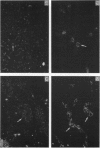Abstract
Ontogeny of quail complement was examined in terms of serum C3 level, cytolytic activity of total complement, functional activity of C3 via the classical pathway (CCP) and an alternative route (ACP), and the distribution of C3-bearing cells. In serum, C3 was detected from 7-day-old embryos by rocket immunoelectrophoresis. Thereafter, its concentration increased rapidly and reached the adult level at 4-5 weeks of age. Total activities of serum complement via CCP and ACP, both of which were assayed by cell lysis, were detected first in 10-day-old embryos, and increased sharply after hatching, reaching the maximum level at 5 weeks of age. Deposition of C3 on the cell surface via CCP and ACP was also clearly demonstrated from 10-day-old embryos by haemagglutination and immunofluorescence techniques, respectively. By an immunofluorescence technique using anti-quail C3 monospecific serum, cells belonging to the reticuloendothelial system were indicated to serve major sites for the synthesis of C3 during ontogenesis.
Full text
PDF
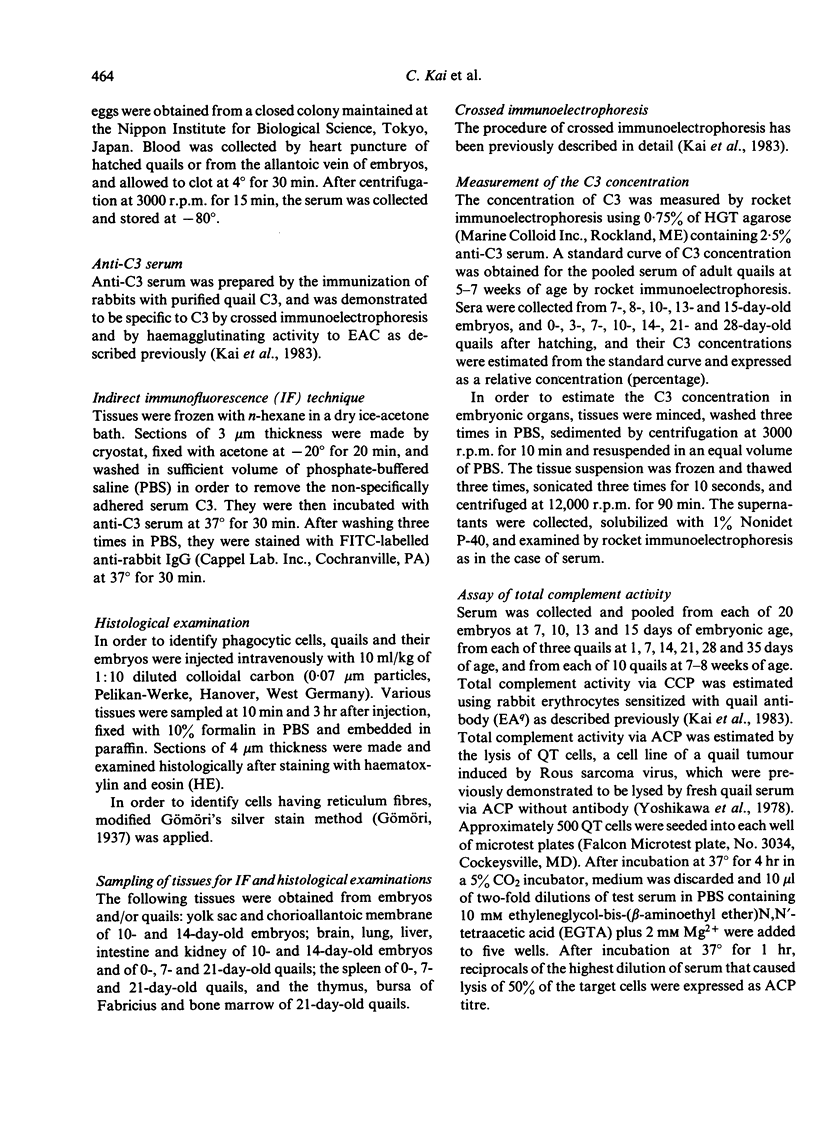
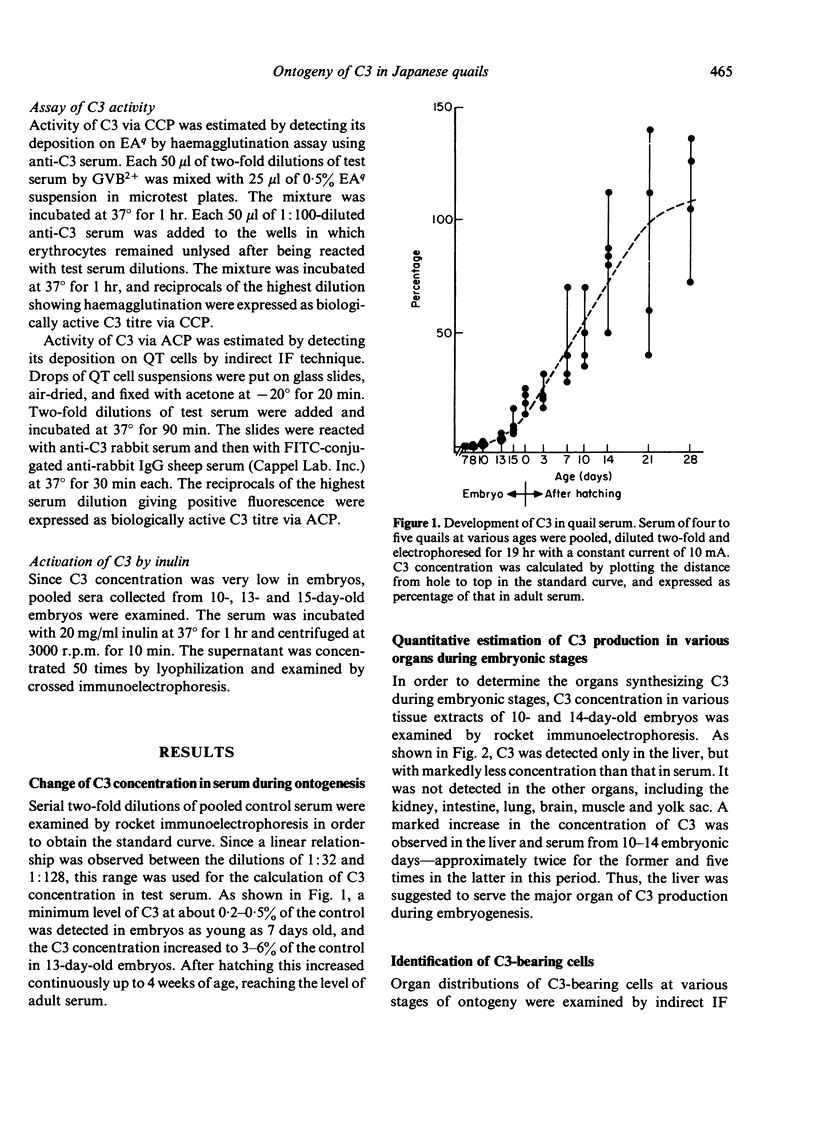
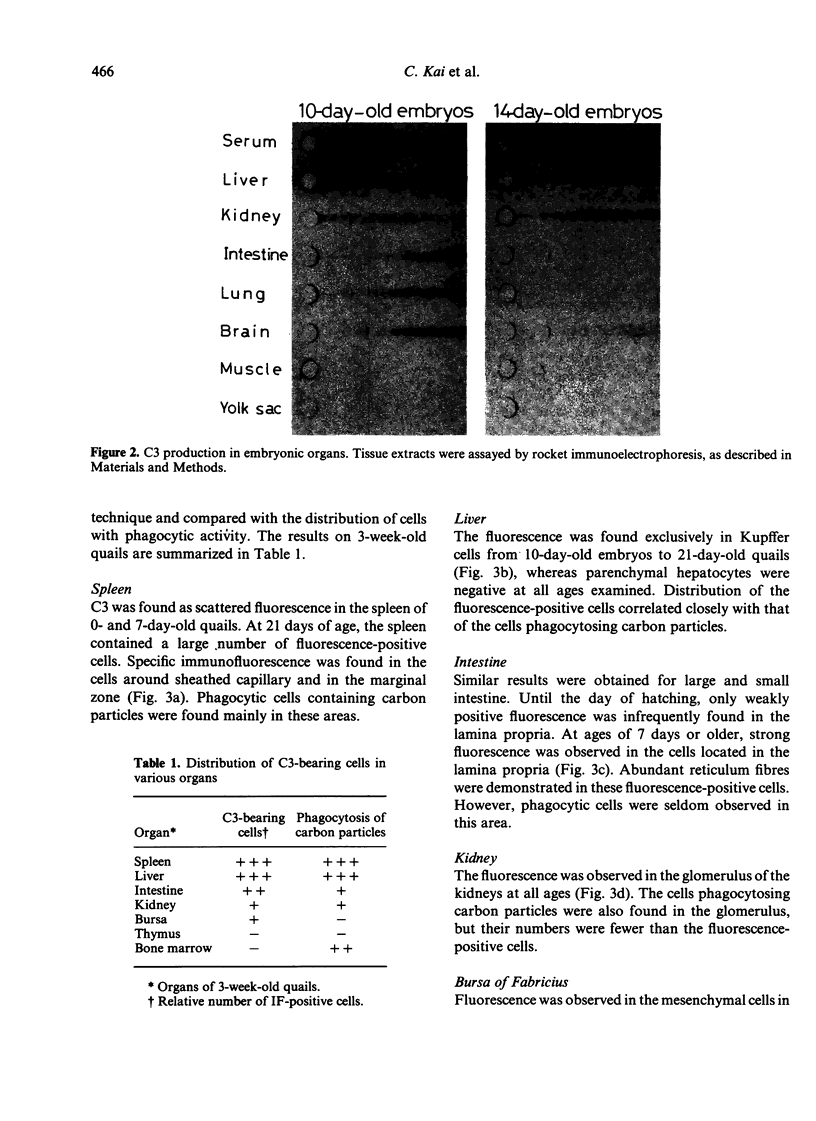

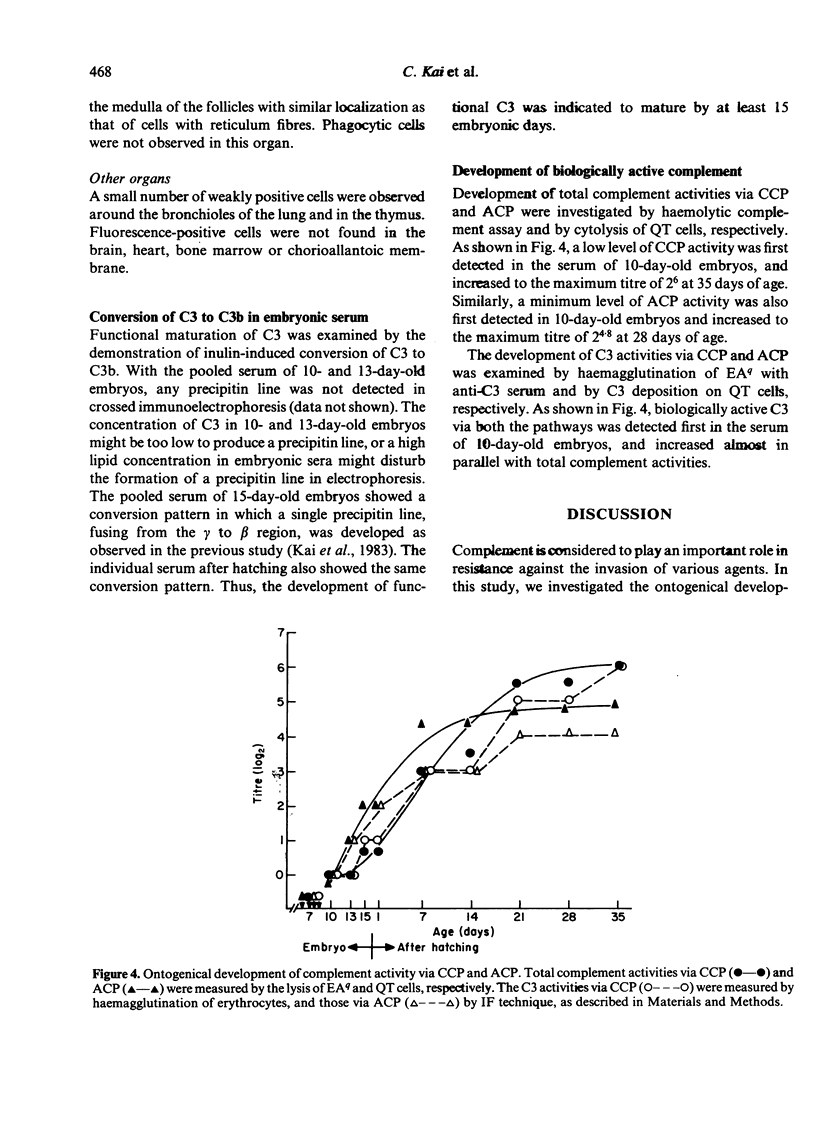
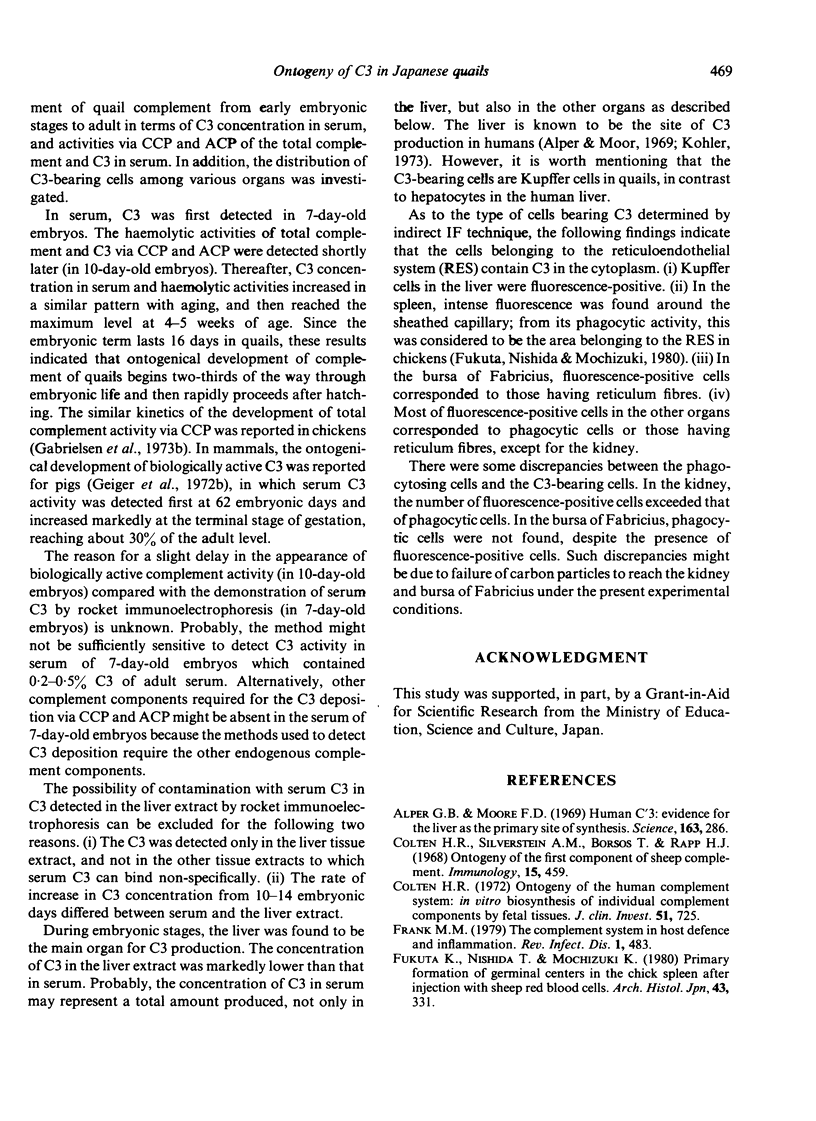
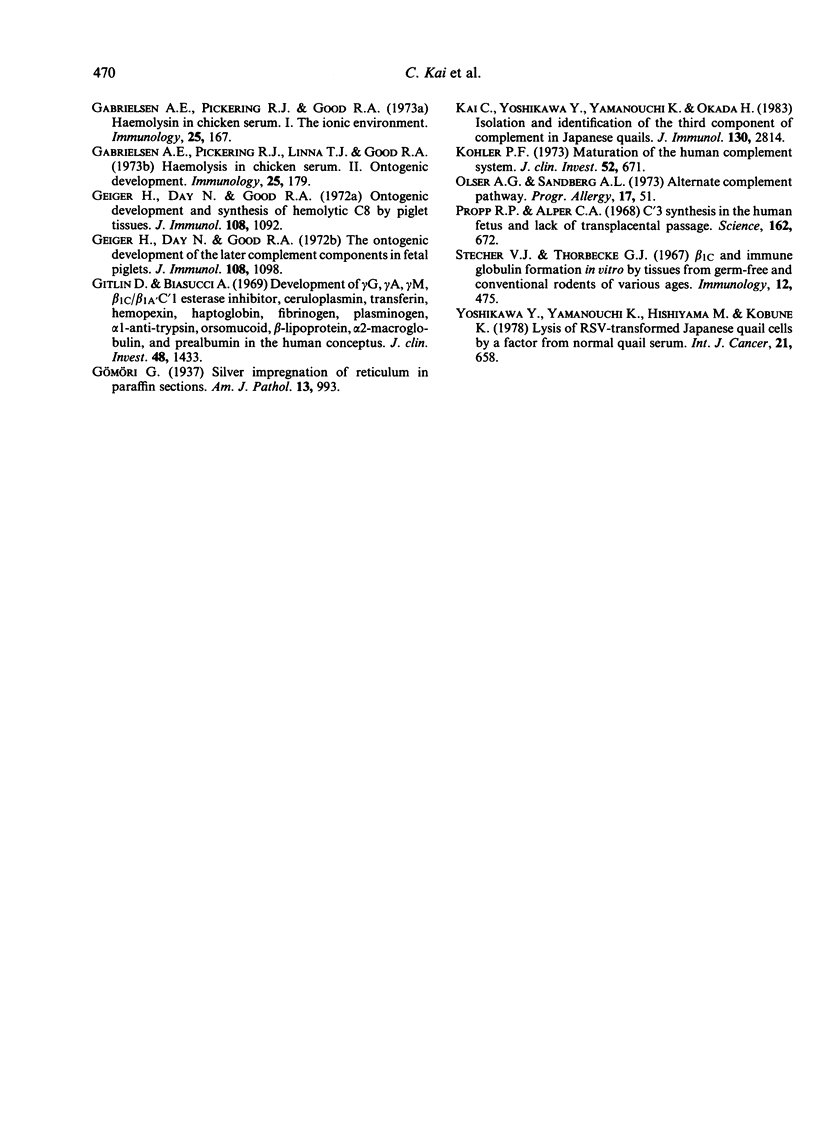
Images in this article
Selected References
These references are in PubMed. This may not be the complete list of references from this article.
- Alper C. A., Johnson A. M., Birtch A. G., Moore F. D. Human C'3: evidence for the liver as the primary site of synthesis. Science. 1969 Jan 17;163(3864):286–288. doi: 10.1126/science.163.3864.286. [DOI] [PubMed] [Google Scholar]
- Colten H. R. Ontogeny of the human complement system: in vitro biosynthesis of individual complement components by fetal tissues. J Clin Invest. 1972 Apr;51(4):725–730. doi: 10.1172/JCI106866. [DOI] [PMC free article] [PubMed] [Google Scholar]
- Colten H. R., Silverstein A. M., Borsos T., Rapp H. J. Ontogeny of the first component of sheep complement. Immunology. 1968 Sep;15(3):459–461. [PMC free article] [PubMed] [Google Scholar]
- Frank M. M. The complement system in host defense and inflammation. Rev Infect Dis. 1979 May-Jun;1(3):483–501. doi: 10.1093/clinids/1.3.483. [DOI] [PubMed] [Google Scholar]
- Fukuta K., Nishida T., Mochizuki K. Primary formation of germinal centers in the chick spleen after injection with sheep red blood cells. Arch Histol Jpn. 1980 Oct;43(4):331–339. doi: 10.1679/aohc1950.43.331. [DOI] [PubMed] [Google Scholar]
- Gabrielsen A. E., Pickering R. J., Good R. A. Haemolysis in chicken serum. I. The ionic environment. Immunology. 1973 Aug;25(2):167–177. [PMC free article] [PubMed] [Google Scholar]
- Gabrielsen A. E., Pickering R. J., Linna T. J., Good R. A. Haemolysis in chicken serum. II. Ontogenetic development. Immunology. 1973 Aug;25(2):179–184. [PMC free article] [PubMed] [Google Scholar]
- Geiger H., Day N., Good R. A. Ontogenetic development and synthesis of hemolytic C8 by piglet tissues. J Immunol. 1972 Apr;108(4):1092–1097. [PubMed] [Google Scholar]
- Geiger H., Day N., Good R. A. The ontogenetic development of the later complement components in fetal piglets. J Immunol. 1972 Apr;108(4):1098–1104. [PubMed] [Google Scholar]
- Gitlin D., Biasucci A. Development of gamma G, gamma A, gamma M, beta IC-beta IA, C 1 esterase inhibitor, ceruloplasmin, transferrin, hemopexin, haptoglobin, fibrinogen, plasminogen, alpha 1-antitrypsin, orosomucoid, beta-lipoprotein, alpha 2-macroglobulin, and prealbumin in the human conceptus. J Clin Invest. 1969 Aug;48(8):1433–1446. doi: 10.1172/JCI106109. [DOI] [PMC free article] [PubMed] [Google Scholar]
- Gömöri G. Silver Impregnation of Reticulum in Paraffin Sections. Am J Pathol. 1937 Nov;13(6):993–1002.5. [PMC free article] [PubMed] [Google Scholar]
- Kai C., Yoshikawa Y., Yamanouchi K., Okada H. Isolation and identification of the third component of complement of Japanese quails. J Immunol. 1983 Jun;130(6):2814–2820. [PubMed] [Google Scholar]
- Kohler P. F. Maturation of the human complement system. I. Onset time and sites of fetal C1q, C4, C3, and C5 synthesis. J Clin Invest. 1973 Mar;52(3):671–677. doi: 10.1172/JCI107228. [DOI] [PMC free article] [PubMed] [Google Scholar]
- Propp R. P., Alper C. A. C'3 synthesis in the human fetus and lack of transplacental passage. Science. 1968 Nov 8;162(3854):672–673. doi: 10.1126/science.162.3854.672. [DOI] [PubMed] [Google Scholar]
- Stecher V. J., Thorbecke G. J. Beta-1C and immune globulin formation in vitro by tissues from germ-free and conventional rodents of various ages. Immunology. 1967 Apr;12(4):475–487. [PMC free article] [PubMed] [Google Scholar]
- Yoshikawa Y., Yamanouchi K., Hishiyama M., Kobune K. Lysis of RSV-transformed Japanese quail cells by a factor from normal quail serum. Int J Cancer. 1978 May 15;21(5):658–666. doi: 10.1002/ijc.2910210518. [DOI] [PubMed] [Google Scholar]




